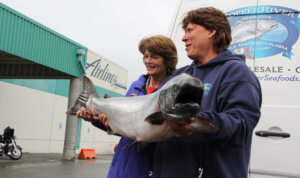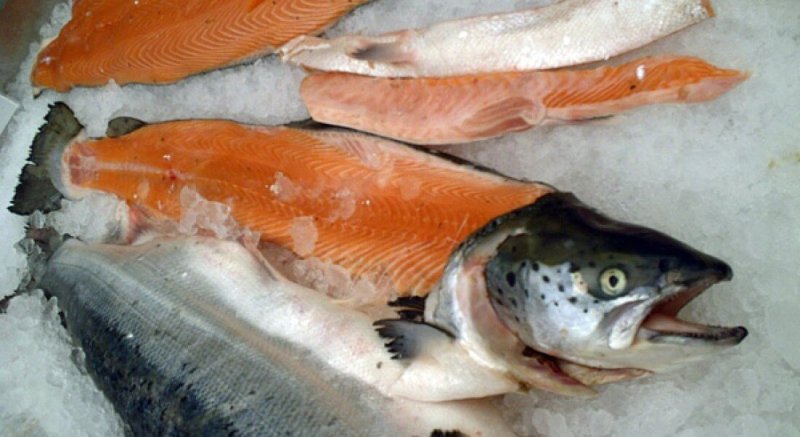“Laws, like sausages, cease to inspire respect in proportion as we know how they are made.”
The true version of a quote that 19th century Germany’s “Iron Chancellor” Otto von Bismarck likely never uttered nonetheless illustrates how, at least for genetically engineered salmon, watching current lawmaking on GE food is putting this new fish into a grind.
For the AquAdvantage salmon, an Atlantic salmon modified to grow twice as fast as conventional Atlantic salmon and far more sustainably, the true grinding action is coming from two conflicting directions:
- A law introduced by Alaska Senator Lisa Murkowski and signed into law by President Obama in December 2015 that will not allow sale of the GE salmon until the US Food and Drug Administration publishes information guidelines and mandates labels.

Protectionist-focused Alaska Senator Murkowski - Another law—the bioengineering labeling statute passed in 2016—introduced by Sens. Pat Roberts of Kansas and Debbie Stabenow of Michigan––blocks states from creating their own GM/GE labels, and calls for the US Department of Agriculture to create final labeling guidelines.
For its part, the USDA has stated that it will not issue such a label, because that’s now the FDA’s job.
Under a third statute, the Omnibus Appropriations Act for fiscal year 2017, AquaBounty salmon is prohibited commercially in the United States until “the FDA publishes final labeling guidelines informing consumers of such content.”
What a legislative mess.
So, where does that leave genetically modified salmon in the United States? Stuck in the grind.
AquaBounty has stated:
We frustratingly read, almost on a daily basis, about the crisis within the salmon industry with imposed cuts in the fishing season and unable to support the demand for salmon. The Company remains committed to growing our business outside the US whilst continuing to press for resolution from the FDA on this matter in the US.

These new laws have stymied the company’s entry into the US market, even though the FDA approved the AquaBounty salmon as safe to eat in 2015 (as did Health Canada, subsequently). Meanwhile, the GE fish was approved for sale in Canada in 2016. In August 2017, AquaBounty said it had sold 5 tons of AquAdvantage salmon fillets to customers in Canada.
In addition to its facilities in Canada and Panama, AquaBounty in 2017 acquired a land-based fish farm in Indiana, to complement its facility on Prince Edward Island to be used to raise the genetically modified salmon. The GE salmon was developed by the insertion of a growth hormone gene from Chinook salmon into Atlantic salmon, and a promoter sequence from ocean pout. This genetic combination allows it to reach market weight about twice as fast as the conventional fish, opening the door to higher fish yields using less inputs to meet increasing demand. The land-based tanks also were considered to be less of an impact on the environment, since they are contained facilities and don’t allow waste (or escaped fish) into the marine environment.
“Both of these facilities must be approved by the FDA prior to their initial stocking with AquAdvantage Salmon, but we anticipate both to be operational in 2018 with a first harvest of commercial production in late 2019,” the company has said.
Opposition to the salmon has been limited but fierce from old-line environmentalists and some environmental groups, however. Food and Water Watch, Greenpeace, Friends of the Earth and the David Suzuki Foundation among other vocal advocacy groups have campaigned against the fish; joined lawsuits against regulatory authorities in the US and Canada; and filed a litany of complaints against adopting the genetically modified fish with government institutions.
And salmon fisheries in places like Alaska and British Columbia, which wielded an economic impact of $750 million at least in Alaska, until overfishing and the impact of farmed salmon reduced the “wild” harvest value to about $125 million in 2002. As of September 2017, the total value of Alaska’s seafood (including but not limited to salmon) “creates an estimated 99,000 FTE jobs, $5.2 billion in annual labor income, and $12.8 billion in economic output,” according to ASMI, an Alaskan trade group. These industries have long supported regional politicians like Sen. Murkowski, who also have opposed the fish.
Hence some of the laws, some legal experts suggest.
Drew Kershen, emeritus professor at the University of Oklahoma College of Law and authority on agricultural legal issues, wrote that:
The Murkowski rider is law only for fiscal year 2017. It should expire on July 1, 2018. Of course, Senator Murkowski could introduce another rider to continue the ban on AquaBounty Salmon beyond that date. In fact, I expect the senator to do precisely that because….by July 1, 2018 or shortly thereafter, the USDA is required to have mandatory labeling regulations in place for GMO foods. If the USDA meets that July 1, 2018 deadline, then the FDA should simply adopt the USDA food label. At that point the FDA obligation under the Murkowski rider would be satisfied. That explains why I said that I expect the Senator to introduce another rider or a slightly amended rider. I have the intuition that the FDA does not want to issue a label, certainly not by its lonesome self, because to do so will incur political wrath from Senator Murkowski and the Alaska congressional delegation. But it could be that FDA honestly considers its hands tied by the GMO Mandatory Labeling Law.
For the moment, AquaBounty is a little more optimistic. According to the company’s response to the 2018 Omnibus Budget Bill:
All this has to be seen against the backdrop of clear rejection of the contentious language regarding labeling previously introduced by Senator Murkowski. The current language is a simpler one—introduction predicated on the FDA finalizing labeling guidance—and does not contain labeling instruction to the FDA. Hence the onus is now firmly on the FDA alone. However, neither the appropriations language nor publishing a guidance compels the FDA to move quickly, or at all, on the import alert.
Sausage-grinders and law-making watchers are still in for a ride.
Andrew Porterfield is a writer and editor, and has worked with numerous academic institutions, companies and non-profits in the life sciences. BIO. Follow him on Twitter @AMPorterfield.































